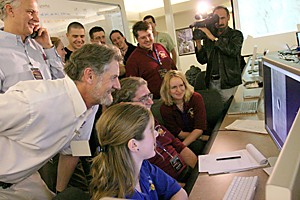All systems are go as the preliminary batch of pictures arrived from the Red Planet on Friday and Saturday.
The UA-operated High Resolution Imaging Science Experiment camera transmitted four test images early Friday morning after taking the pictures the previous night. Another four were taken on Saturday, sources said.
The $60-million HiRISE camera is aboard the Mars Reconnaissance Orbiter, which is currently reducing orbit around Mars until it reaches a circular orbit some time in September. The camera will not take any more pictures until that time.
Project leaders said they were happy with the success of the camera.
“”That was the moment we were looking forward to,”” said Alfred McEwen, HiRISE team leader. “”We knew the camera worked right.””
When the first picture was taken, the MRO had a ground speed of 1.7 kilometers per second, McEwen said.
The relative resolution of the preliminary images is roughly the same as the pictures taken by the Mars Global Surveyor.
When the probe reaches its circular science orbit in the fall, the resolution will be eight or nine times greater, McEwen said.
In addition to scouting future landing sites, the pictures will give scientists a window into Mars’ geological past.
“”We want to understand the origins of the features,”” McEwen said. “”We want to resolve boulders that have been transported.””
The images will give clues to researchers as to whether the surface of the planet was created by water flow, ice flow or even lava flow, McEwen said.
The first picture was taken northwest of the Argyre Planitia region in the southern hemisphere.
Researchers at the HiRISE operation center stayed up well past midnight to see the first image.
“”I did a live Web-log that people all over the world could see,”” said Loretta McKibben, information specialist coordinator for the Lunar Planetary Lab. “”We were here until 6 in the morning.””
The excitement level was high when the first image appeared on the computer screen.
“”I started crying a little bit and laughing some of the time,”” said Tahirih Motazedian, an operation specialist. “”I felt like I was there at the same time.””
The test images gave the HiRISE team an opportunity to calibrate the instruments and refine working with the images, Motazedian said.
Other technicians were happy to see everything work as planned.
“”It was relief among other things,”” said Jim Bergstrom, a HiRISE system engineer. “”Excitement and relief.””
Bergstrom has been working on the project for the past four years. His company, Ball Aerospace and Technologies, assembled the camera.
As of press time, only the first image was released to the public, but remaining pictures should be available within a few weeks, McEwen said.
The HiRISE camera is the most powerful telescopic camera to be sent outside Earth’s orbit.
More than 34 terabytes of information are expected to be returned within the mission’s first two years.
HiRISE is managed at the Charles P. Sonett Space Sciences building on campus.









